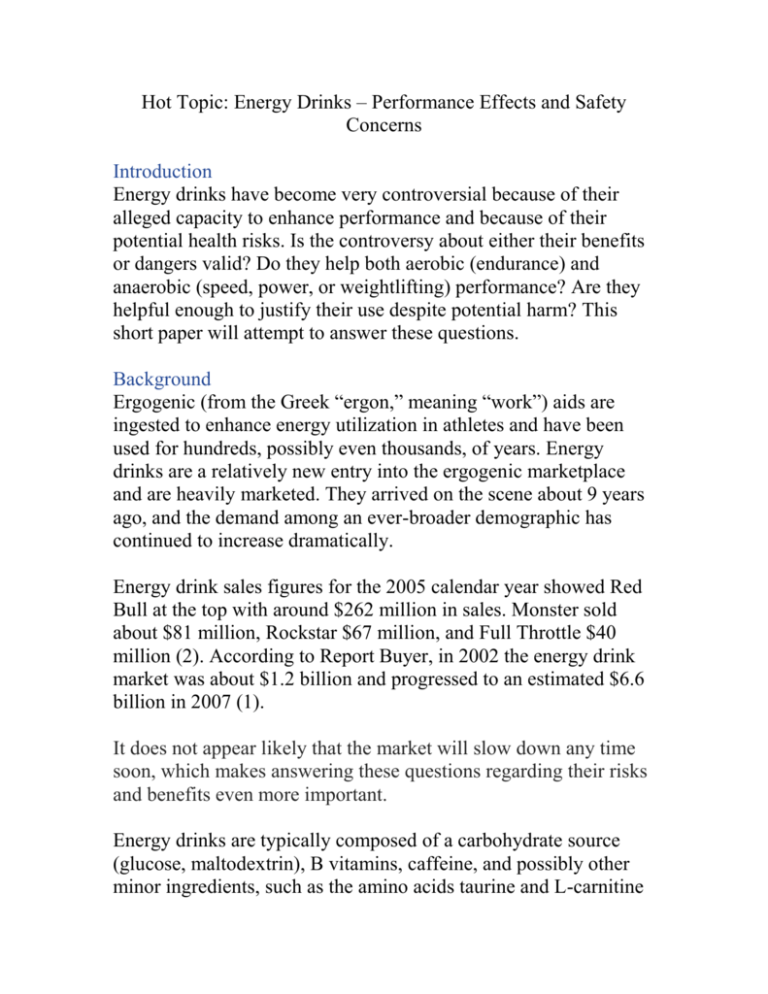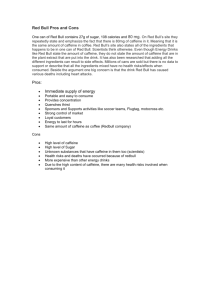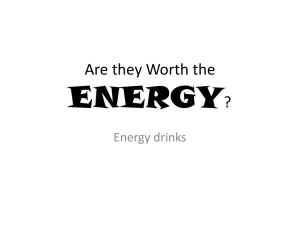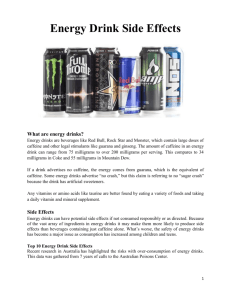Energy Drinks: Performance & Safety - A Research Overview
advertisement

Hot Topic: Energy Drinks – Performance Effects and Safety Concerns Introduction Energy drinks have become very controversial because of their alleged capacity to enhance performance and because of their potential health risks. Is the controversy about either their benefits or dangers valid? Do they help both aerobic (endurance) and anaerobic (speed, power, or weightlifting) performance? Are they helpful enough to justify their use despite potential harm? This short paper will attempt to answer these questions. Background Ergogenic (from the Greek “ergon,” meaning “work”) aids are ingested to enhance energy utilization in athletes and have been used for hundreds, possibly even thousands, of years. Energy drinks are a relatively new entry into the ergogenic marketplace and are heavily marketed. They arrived on the scene about 9 years ago, and the demand among an ever-broader demographic has continued to increase dramatically. Energy drink sales figures for the 2005 calendar year showed Red Bull at the top with around $262 million in sales. Monster sold about $81 million, Rockstar $67 million, and Full Throttle $40 million (2). According to Report Buyer, in 2002 the energy drink market was about $1.2 billion and progressed to an estimated $6.6 billion in 2007 (1). It does not appear likely that the market will slow down any time soon, which makes answering these questions regarding their risks and benefits even more important. Energy drinks are typically composed of a carbohydrate source (glucose, maltodextrin), B vitamins, caffeine, and possibly other minor ingredients, such as the amino acids taurine and L-carnitine and some herbs. Despite the great deal of data on caffeine and the use of carbohydrates to enhance aerobic exercise performance, (3, 9-11, 18, 29, 30) there is little data on the effects of energy drinks on exercise performance, especially from randomized controlled trial formats. Effects of Energy Drinks on Aerobic Exercise Performance Candow and colleagues investigated the effects of a sugar-free Red Bull energy drink on high-intensity run time to exhaustion in young adults(4). Physically active university students (9 men, 8 women, aged 21 ±4 years) participated in a double-blind, crossover, repeated-measures study. Each subject was randomized to the supplement group (sugar-free Red Bull at 2 mg/kg body mass of caffeine) and a non-caffeinated, sugar-free placebo (tonic water with lime juice) with 7 days between tests. A run time to exhaustion test at 80% VO2 max was performed while rating of perceived exertion (RPE) was assessed immediately after exercise. They found no differences in run time to exhaustion (Red Bull: 12.6 ±3.8 minutes, placebo: 1.8 ±3.4 minutes), or perceived exertion on a Borg scale (Red Bull: 17.1 ±2.0, placebo: 16.6 ±1.8) between groups. Ivy and company investigated the effects of a commercially available energy drink ingested before exercise on endurance performance (17). This study also used a double-blind, randomized, crossover design. Subjects (6 male and 6 female) were trained cyclists (mean age 27.3 ±1.7 years, mass 68.9 ±3.2 kg, and VO2 peak 54.9 ±2.3 ml/kg/min) and arrived to the lab after an overnight (12-hour) fast. They consumed 500 ml of either a flavored placebo or Red Bull Energy Drink (160 mg caffeine with 54 g carbohydrate). Performance was measured as time to complete a standardized amount of work equal to 1 hour of cycling at 70% wVO2 max. Performance improved with the energy drink compared with placebo (3,690 ±64 s vs. 3,874 ±93 s, p < .01), although there was no difference in ratings of perceived exertion (RPE). Respiratory exchange ratio (RER) was also evaluated to investigate substrate (fat or carbohydrate) utilization by open-circuit spirometry and did not differ between treatments. The conflicting results of these two studies from Candow and Ivy may be related to the different study designs and the mode of exercise. For example, Candow (4) used a run to exhaustion yet Ivy (17) used a cycling time trial. Furthermore, it remains difficult to pinpoint the potential ergogenic ingredient(s) in energy drinks, such as carbohydrates and caffeine. Carbohydrates and fluids have been repeatedly shown to be ergogenic when given before and during endurance exercise (18, 19, 22, 24, 27-30). There is substantial information that shows caffeine can improve endurance performance (9, 10), but the combination of ingredients in energy drinks may inhibit this improvement in performance. Effects of Energy Drinks on Anaerobic Exercise Performance Not all athletes engage in aerobic-based sports, as some sports are anaerobic in nature. With that said, perhaps there is an ergogenic effect of an energy drink taken pre-exercise in anaerobic-based performance? Forbes and company studied the effects of Red Bull at 2 mg/kg body mass caffeine as compared to those of a placebo (noncaffeinated Mountain Dew with lemon juice) (8). Sixteen healthy, physically active subjects (12 men, 4 women, aged 24 ±6 years) volunteered for the study. After a familiarization trial, subjects were randomized to groups and accordingly ingested either the supplement or a placebo 60 minutes before exercise. Muscle strength and endurance was measured by 1-rep max (1RM) bench press test where subjects performed 3 sets of reps to volitional fatigue at 70% of their 1RM. Anaerobic power was assessed by repeated 30-second Wingate cycle ergometer tests with resistance set at 7.5% of their body mass. The Red Bull group was found to increase the total bench press reps vs. that of the placebo group (34 ± 9 reps vs. 32 ± 8 reps, p<0.05), but had no effect on peak anaerobic power (701 ± 124 W vs. 700 ± 132 W) or average power (479 ±74 W vs. 471 ±74 W) for the Red Bull vs. placebo, respectively. From this study, Red Bull improved bench press rep performance but not anaerobic power. Conclusion Despite the great deal of data on the main active ingredients in energy drinks (caffeine and carbohydrates), there is limited data to show that they enhance aerobic or anaerobic exercise performance. Safety The albeit brief history of energy drinks contains many case reports of acute short-term effects, but substantial data to determine the validity of any and all claims regarding short- or long-term effects is yet to come (5-7, 25). More safety data is always a good thing, but that argument could be made for any supplement or even some common food items. Energy drinks are no different in this regard. The main active stimulant in most energy drinks is caffeine since it is cheap and effective. Recently, Canada passed new rules limiting caffeine levels at 180 mg per drink (12). For comparison, the average cup of coffee contains between 40 and 150 mg caffeine, although specialty coffees may contain much higher doses (20). "The dose makes the poison" – Paracelsus A substance can produce the harmful effect once it reaches a high enough dose. Caffeine is one of the most studied substances in the food supply and has a long history with overwhelming scientific evidence supporting its safety when consumed in moderation (13). Fatal caffeine overdoses in adults are relatively rare and require ingestion of a large amount of the drug, typically in excess of 5 g or 5,000 mg (20). At 120 mg caffeine per average cup of coffee, that amounts to about 41 cups of coffee. While there are a handful of case reports of caffeine overdosing in the literature (16, 20, 26), they are very rare especially considering the broad accessibility of caffeine. The effective dose where an ergogenic effect is seen is about 2-6 mg caffeine/kg body mass; so a 220-pound athlete would need about 200 to 600 mg or 1.5 to 5 averaged-sized cups of coffee to potentially enhance performance (9). Too much caffeine, on the other hand, can potentially be ergolytic (detrimental to performance) (9). For athletes monitoring performance, an increased dose of caffeine will show a performance drop-off well before they approach the amount close to acute caffeine toxicity. Based on the data reviewed by Nawrot and colleagues in 2003(23), up to 400 mg of caffeine daily was not associated with any adverse effects in healthy adults. The study did state that children should limit their consumption to less than 2.5 mg/kg bodyweight/day. Higdon and company (14) presented data (also in children), that no adverse effects were seen with doses under 3 mg/ kg bodyweight/day; however, the exact amount of caffeine will vary from person to person based on genetics, body mass, and sensitivity. For reference, a youth athlete weighing 120 lb (54.4 kg) at 3 mg/kg body mass caffeine calculates out to 163 mg of caffeine per day, or about 2 servings of an average energy drink (average caffeine per serving of Red Bull is 81 mg). Recommendations While clear-cut recommendations for athletes do not exist, some groups such as the Mayo Clinic do not recommend energy drinks for athletes participating in exercise lasting less than 1 hour (15), but also admit there is a lack of long-term data to support this conclusion. Even when consumption of an energy drink results in a statistical increase in performance, this translates into a very small real-world change; it will not transform anyone into the next Olympic athlete overnight. The main ergogenic ingredient (caffeine) has a great safety record when used in moderation. The longest-term data available in the literature on one type of energy drink (Celsius) taken once a day for 10 weeks did not show any change in clinical markers for hepatic, renal, cardiovascular, or immune function, and revealed no adverse effects in response to its consumption (21). Unfortunately there are not any other data investigating other types of energy drinks for a similar length of time, especially accounting for a higher total dose and frequency. Based on current data, it appears that an occasional energy drink with regard to acute health risks is safe; but long-term studies have not yet been conducted. Source: NSCA




